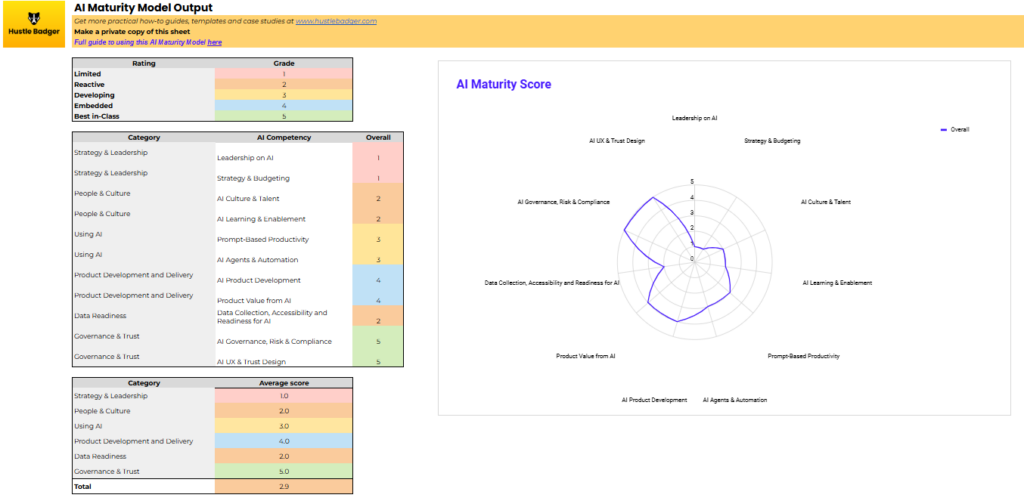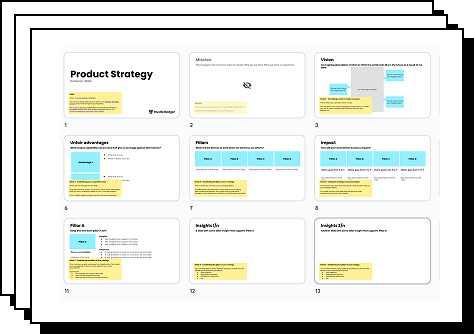An AI maturity model is a structured tool that helps you assess how ready your organisation is to use AI effectively and sustainably.
Completing one helps you have a benchmark, know where to work, and develop roadmaps towards maturity. It also helps with shared language and understanding, plus create ownership of different maturity goals.
This article includes the following artefacts:
- AI Maturity Model: dimensions grouped by category where you can score your organization’s AI maturity from limited to best in class,
- AI Maturity Evaluation Summary: an output which shows your score overall and by category, making strengths and weaknesses easy to visualize
- AI Maturity Development Canvas: a goal setter and project tracker for you to set AI maturity targets, link actions and set responsibilities
- Implementation guide: how to use and adapt the model within your organizational context
The benefits of using an AI Maturity Model to assess your organization include:
- Benchmarking: score where you are today and identify strengths and weakness
- What good looks like, where: AI is both relatively new, and fast moving. It’s hard to know what should be happening across multiple functions and areas, and harder therefore to have a conversation about what to do
- Identify gaps and risks: where you have capability gaps or potential trust and governance weaknesses
- Create a development plan and tracker: identify which areas you’d like to invest in, what you’d like to score and how you’ll get there
We’ll take you through why and when to use an AI maturity model, how to use it to assess your organization, and how to treat it as a living document, as the landscape both outside and inside your company evolves.
Not every organization will score “Level 5” across the board. This model is designed to identify which dimensions matter most to your team and support your goals with a development canvas for your priorities.
We provide a full AI maturity model, evaluation scorecard and development canvas that you can evolve and adapt to your context.

The Hustle Badger AI Maturity Model
Why use an AI maturity model?
An AI maturity model creates transparent expectations of what AI skill level and behaviors look like across multiple teams, tasks and levels of the hierarchy.
It helps make AI planning concrete, and take it to an actionable plan to help the organization benefit. It can clarify where investment is needed in business infrastructure, capabilities and tools.
This is especially useful in a new area like AI where different skill levels and functions have different ideas and beliefs about what good looks like.
In addition AI comes with customer and internal risk factors and requirements. Completing an AI maturity assessment exercise creates a benchmark for leadership around the organization’s readiness to take on AI tasks, gaps and the potential risk register when it comes to ethical AI and governance.
The benefits include:
- Shared language: enabling teams across different functions to talk about AI capability with clarity.
- Gap analysis: identifying where you’re strong, where you’re weak, and what’s missing
- Business case for needs: enthusiasm for the possible benefits of AI is translated into actionable investment areas, be it time, upskilling or infrastructure
- Capability mapping, hiring and upskilling plan: allows you identify areas where you need to hire new profiles
- Onboarding: Explains to new joiners what is expected of them in terms of AI mindset, skills, and the organizational AI roadmap and culture
- Foundations: protocols, governance and infrastructure required to implement, scale and monitor AI while managing risk
We believe that defining levels of AI preparedness and competency is particularly useful because
- Nascent area: AI is new and fast moving. There’s significant variance in how people are deploying it, what good looks like from a skills and governance perspective, and where people should invest to succeed. There’s not yet a playbook, and thus companies have to invest in their own.
- Internal audit: there can be confusion within companies about why AI is not being deployed, when there may be very rational reasons (data, governance, skills, budget). This type of exercise can clarify where the blockers are and help the organization overcome them.
The model can help you avoid other pitfalls when it comes to adopting and deploying AI, such as:
- Passive resistance: Cultural issues, which need persuasion, upskilling, hiring and performance improvement plans.
- Lack of centralised plans for AI: Fragmented, ad hoc initiatives across the org, with no centre of gravity
- Lack of focus or effectiveness: Pilots or MVPs which stall at hurdles, or go live with no value tracking; or members of the organization not making time to upskill
- Insufficient infrastructure: Insufficient investments in or understanding of the required infrastructure to scale and iterate
- Data hygiene and accessibility: Issues with data quality, infrastructure or successful collection and deployment of key data
- Governance and trust risks: Limited understanding of ethics and risks results in moving faster than governance and oversight, creating hazards
Our AI maturity assessment is part of a suite of management tools which can meaningfully improve how you set strategies, manage teams and fill capability gaps:
Limitations and downsides
As with any other tool or template, the value of this AI maturity model depends on your business context and the internal culture and appetite to invest in this exercise.
Watch out for the following downsides:
- Heavy lift: investing in increasing AI capability across an organization requires significant cultural, competency, tooling and capability transformation. If you’re not ready to do that, don’t move forwards
- Fear factor: in less AI mature organizations rolling out this type of exercise can create layoff fear, or push back. You need a comms plan and change management process in preparation for this.
- Increased bureaucracy: The purpose of the model is to create clear benchmarks and give guidance. Increased clarity should be helpful but it can also be restrictive. It’s important to understand that you will face rigidity and to combat it with flexibility.
- Lifecycle and maintenance: AI is a fast moving space, and maturity models and spectrums can quickly go out of date, or miss new functionality. It’s important to keep evolving the model, and invest in maintenance and iteration, plus re-scoring exercises
- May require budget: you may find as you go through the model that investment is required to increase capability: in people, engineering processes, data or systems.
Used well, the benefits of using a model like this should outweigh the people risks and investments, but it’s important to sign up in advance to these.



